

OUR VERY BEST
This gallery is specially curated to exhibit some of the finest and most famous specimens we have handled. The pieces in this gallery reflect the most desirable traits attainable for each species and locality, and are recognized as "legends" in our industry.

THE JAMES HORNER EMERALD
Emerald on Calcite
Coscuez Mine, Western Boyacá Province, Boyacá Department, Colombia
5.1 x 5.3 x 4.5 cm
The James Horner Emerald is regarded as the standard for Muzo Emeralds. The specimen was formerly part of the renowned mineral collection of James Horner, the American composer, who was also an avid mineral collector. The Horner collection is still considered one of the greatest ever assembled. This specific Emerald is known for its exceptional qualities, including a deep, rich color and a large, thick, double-terminated crystal sitting atop a perfectly undamaged Calcite crystal. Emeralds of this level are unattainable and of the highest level.
Salim Eddé later purchased the Emerald, where it lived in the MIM Museum, which is regarded as the finest mineral collection ever assembled. The piece also lived in the world famous collections of Daniel Trinchillo, as well as Stuart Wilensky. In the mid 2010s, the piece was sold into the Irv Brown collection. Additionally, this piece was exhibited by the Gemological Institute of America and was featured in the world-renowned "Fura's Tears" Emerald exhibition in 2019 in New York City. This specimen is now with an elite private collector, and is also pictured in the Ikons II book.
This crystal also reflects not only the characteristics of a perfect, standard-setting Emerald, but also for mineral specimens in general. Aside from the Emerald exhibiting the finest qualities possible, it also sits perched on a flawless and complete Calcite crystal. A beautiful array of contrasting clear and gray Calcite crystals separate the Emerald from the Calcite, which ties the piece together beautifully. In terms of refinement, quality and fame, there is no rival, comparable or equal.

JANUS
Calcite on Dolomite and Quartz with Sphalerite
The Jewel Pocket, Elmwood Mine, Carthage, Smith County, Tennessee
8.8 x 9.4 x 6.1 cm
Janus, the god of beginnings, endings, and transitions is a distinctively famous figure in Roman mythology. Janus retains a notable attribute, he is always pictured with two faces; one looking to the past and the other to the future. Janus symbolized the duality of time and was invoked at the start of any new endeavor. The remarkable symmetry of this Calcite specimen, formed by two perfectly twinned crystals, imparts a distinctive "two-faced" appearance that aptly inspired its namesake.
Aside from this evocative Calcite crystal being one of the most striking and famous Calcites from the Elmwood Complex, specifically the Jewel Pocket, it ranks amongst the finest Calcite crystals in the world from any locality. This piece was formerly in the collection of Mark Kielbaso, and then later the collection of Will Johnson. The crystal was then featured in a Manhattan mineral specimen exhibition, which highlighted six of the worlds most beautiful and entrancing crystals.
This specimen exemplifies the finest qualities attainable in Calcite. Each crystal face is exceptionally glassy and smooth, with a stunning mirror-like luster. The rich honey-cognac colors, particularly intense at the terminations is the most coveted hue among Tennessee Calcites. The specimen's overall symmetry and form are outstanding - showcasing a perfectly twinned Calcite crystal aesthetically perched atop a sparkling Dolomite and Quartz matrix. At the base, a lustrous Sphalerite crystal adds contrast, completing this exceptional specimen.

THE THREE AMIGOS
Emerald on Matrix
Coscuez Mine, San Pablo de Borbur, Western Boyacá Province, Colombia
5.0 x 5.2 x 5.0 cm
The Three Amigos is one of the most famous Emerald specimens in the world. The piece is instantly recognized for its shocking color, luster, sharpness and impossible clarity. This legendary specimen was originally owned by the esteemed Cargill family. The piece resided in their collection for several years until it was released with a few other major mineral specimens. To this day the Three Amigos is regarded as a standard-setting example for not only Emerald crystals, but also for fame and legendary status in the mineral collecting world.
This piece was later purchased by well-known collector Irv Brown, where the piece resided in his private collection for over a decade. Irv Brown is known throughout the mineral collecting world as one of the most refined, astute and discerning buyers. This piece belonged in the top percentage of his two-time Desautels Trophy winning collection, and is one of the most famous and coveted mineral specimens. In 2019, the Three Amigos won the Walt Lidstrom trophy as well.
The consistent clarity throughout the crystals is an entirely separate wonder. The Three Amigos Emerald also composes a confounding question: How could an Emerald exhibiting such color and clarity not have been cut into gemstones? The fact that this Emerald escaped the gemstone cutting industry is a remarkable feat, as anything that displayed qualities even half as nice as this were immediately collected as gemstone rough to later be cut into highly prized and marketable faceted gemstones. The existence of this Emerald as a specimen is an anomaly.


THE GOLDEN FEATHERS
Crystallized Gold
Serra do Caldeirão claims, Pontes e Lacerda, Mato Grosso, Brazil
6.0 x 7.2 x 5.0 cm
The Golden Feathers is regarded as one of the very finest Brazilian crystallized gold specimens ever recovered. This piece was first purchased by Dr. Stephen M. Neely, one of the world's most famous collectors when the find was debuted for the first time. Shortly after Dr. Neely purchased the specimen, he received an offer for over twice what he paid for the piece. Dr. Neely declined the offer, and kept the specimen in his personal collection until he sold his worldwide specimens as a whole.
The specimen was then purchased by another elite and well-known collector, Andrew Irving. This specimen was part of his finest selection of specimens, and was displayed at the Tucson Gem & Mineral Society Main Show in 2024. The specimen was a crowd favorite, and quickly became instantly recognizable as "The Golden Feathers." This specimen has become the most famous specimen from the find.
The Golden Feathers also exhibits the finest possible qualities of the 2015 find. Typically, crystallized feather-like gold from Brazil is only seen in single feathers. This piece has two perfectly balanced feather-like crystals that face away from each other in a most aesthetic way. The crystals on this piece are also much cleaner and more defined than typical examples, as the majority of examples show crystals that appear more round and dull. The buttery-yellow color is also as good as it can be for the locality, and is what makes the find so unique.


MALACHITE, SHATTUCKITE
Primary Malachite on Shattuckite and Quartz
Omaue Mine, Opuwo Rural, Kunene Region, Namibia
7.1 x 6.5 x 6.3 cm
The Omaue Mine, located in Namibia’s Kunene Region within the Otavi Group limestones, hosts copper-sulfide veins that later oxidized to form rich secondary mineral zones. This process produced striking specimens of Dioptase, Shattuckite, Chrysocolla, and other rare copper minerals. Active since at least the late 1980s, the site gained international fame among mineral enthusiasts for its vibrant dioptase crystals. The mine’s most celebrated find is its rare Primary Malachite crystals perched on vivid blue Shattuckite and glittering Quartz—treasured worldwide by collectors.
This exceptional specimen carries a distinguished provenance, having first belonged to the esteemed Irv Brown before entering the renowned London collection of Bill Ferris, where it remained for many years. Featured on the cover of The Mineralogical Record issue devoted to Namibian localities, it is widely regarded as the finest example ever recovered from the Omaue Mine—a true benchmark of beauty and rarity.
Beyond its vivid and captivating coloration, the true distinction of this specimen lies in its remarkable "liveliness." The Malachite’s luster is nothing short of extraordinary—each crystal facet catches and reflects light with an almost electric brilliance, imbuing the piece with a sense of motion and life. The shimmering matrix enhances this effect, creating a sparkle and depth that transcends description, elevating the specimen from a mineralogical masterpiece to a work of natural art.


THE LIGHTNING BOLT
Gold on Quartz
Valentines Day Pocket, Eagle’s Nest Mine, Michigan Bluff Mining District, Placer County, California
5.2 x 7.8 x 5.0 cm
When polling the mineral collecting world as to the accepted favorite crystallized Gold producing locality, California is the accepted answer. There is something spectacular about the bright, lustrous, razor sharp crystals that come out of the California mines. The most prolific mine in California for crystallized Gold production is the Eagle's Nest Mine, which has produced many of the world's greatest gold specimens. After many years of the site being closed, the mine reopened, and a legendary pocket of crystallized Gold was struck on Valentine's Day of 2024.
This example was one of the main pieces that were debuted at the Tucson minerals shows in January-February of 2025, and it was immediately a favorite amongst mineral enthusiasts and connoisseurs alike. The piece immediately gained the namesake "The Lightning Bolt", and is one of the most famous pieces of the new find. This piece now resides in a private collection.
The specimen stands out boldly. Despite being a small-cabinet sized specimen, this piece has a presence different from most crystallized Golds. The lift of the piece is incredible, as the crystals rise directly out of the bright white Quartz matrix and are free standing in the most aesthetic way. The luster of the crystals is as good as it can be, with mirror like shine on every crystal face. The color is also ideal, displaying a pleasing, bright, golden-yellow color that contrasts stunningly against the white Quartz backdrop. This specimen is a work of art, and has already become one of the most famous and memorable Californian crystallized Gold specimens.

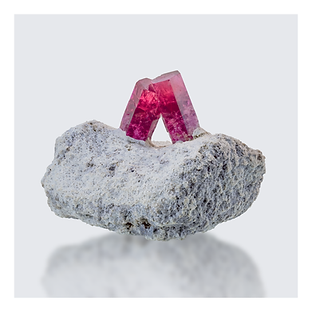
THE CRIMSON KISS
Red Beryl on Rhyolite
Wah Wah Mountains, Utah
7.5 x 6.8 x 6.5 cm
This is likely the most famous Red Beryl specimen in the world. Red Beryls, sometimes referred to as Bixbite (but this name has phased out of mineralogical nomenclature) belong to the Beryl group, and are the rarest members of the family. Quality examples of this rare species only come from one place in the entire world, the Wah Wah Mountains in Utah. There are smaller deposits in the Thomas Range in Utah and a small portion of New Mexico, but the highest quality examples hail from the legendary Wah Wah Mountains.
Formerly in the refined collection of John Seibel, as well as the two-time Desautels Award winning collection of Irv Brown, this piece reflects the characteristics of a connoisseurs specimen. The Crimson Kiss has been exhibited multiple times at the Tucson Gem & Mineral Society Main Show (the Super Bowl of the mineral world), and was recieved as a crowd favorite every time. This piece has also graced several elite private collections over the years, and is currently residing in one of the finest private collections in the world.
This anomalous specimen has two complete Red Beryl crystals that perfectly terminate into each other. The balance and aesthetic of this piece is otherworldly, as is the clarity, color and luster of the crystals. This specimen has remained a staple of the locality for decades; the luminous qualities of the crystals, coupled with the once-in-a-lifetime aesthetic make this piece an icon of the mineral collecting world, and set the standard for the species.


FLUORITE, GEOCRONITE, PERU
Fluorite on Geocronite
Milpo mine, Atacocha mining district, Cerro de Pasco, Pasco province, Pasco, Peru
8.5 x 7.0 x 6.0 cm
In recent years, a remarkable new discovery of green Fluorites were uncovered in Peru, producing a color unlike any other Fluorites in the world. These Fluorites quickly drew attention for their vivid range of colors—from a "sour apple" color (typically seen associated with a Pyrite matrix) ranging to a saturated "radioactive" bluish greens (associated with the much rarer Geocronite matrix). Their sharp crystal morphology and exceptional transparency distinguish them from earlier Peruvian occurrences, marking this discovery as a significant new chapter in the country’s mineral record.
This outstanding specimen exemplifies the finest qualities of the Geocronite-associated green Fluorites from this remarkable Peruvian discovery. It features a large, exceptionally transparent crystal of optimal color—an electric, saturated green that glows vividly against its dark, metallic matrix. The interplay between the gemlike clarity of the Fluorite and the shadowed luster of the underlying Geocronite creates a powerful and almost mysterious visual presence.
What truly distinguishes this piece is its superb symmetry and crystal form, as well as incredible isolation and exposure, with a fully lifted and undamaged crystal sitting perched atop the matrix. While most examples from the find exhibit slightly modified octahedral habits that retain a visually identifiable and more standard Octahedral shape, this specimen displays an unusually balanced morphology, with precisely proportioned faces and edges. The result is a specimen of uncommon elegance and visual drama—undeniably one of the most striking of this modern classic locality.


THE AMABILI VESUVIANITE
Vesuvianite
Jeffrey Mine, Val-des-Sources, Les Sources RCM, Estrie, Québec, Canada
6.0 x 7.5 x 6.7 cm
The famed violet-capped Vesuvianites came from the Jeffrey Mine in Val-des-Sources (formerly Asbestos), Québec. Opened in 1879 as a major chrysotile-asbestos operation, the mine’s ultramafic rocks and rodingite dikes also produced exceptional mineral specimens, including gem-quality Vesuvianite and Grossular Garnet. In the late 1970s, a now-legendary pocket was discovered which yielded a small number of bi-color Vesuvianites. No later discoveries matched this find’s color or crystal quality.
This specimen hails from that very 1979 discovery at the Jeffrey Mine, which closed permanently in the early 2010s when asbestos extraction ended, leaving these rare Vesuvianites as enduring symbols of Canada’s mineralogical heritage. The pocket yielded a very limited number of high-quality Vesuvianites exhibiting mesmerizing bi-color zoning, with lustrous green bodies capped by intense violet terminations of remarkable saturation due to a manganese enrichment.
Among this incredibly small group of specimens, this piece is widely regarded as the quintessential example—one of the finest three ever recovered from the discovery. Formerly part of the Marco Amabili collection which contained the majority of the Vesuvianites in existence, this piece would become one of two superior examples of this style, both of which were subsequently sold together. This specimen exhibits the most vivid and optimal coloration attainable for this specific morphological and chromatic habit of Vesuvianite.

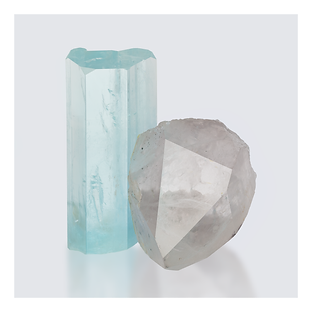
AQUAMARINE WITH QUARTZ, PAKISTAN
Aquamarine with Quartz
Shigar Valley, Gilgit-Baltistan, Pakistan
11.4 x 17.1 x 9.8 cm
Aquamarine is amongst the most desirable mineral species to collect, and this piece is one of the most famous examples. Shigar Valley, in the Gilgit-Baltistan region of Pakistan is known to produce the finest prismatic and euhedral Aquamarine specimens in the entire world. Pakistan has been a key player in the mineral collecting world for decades, and has produced many of the worlds other great gem pegmatite minerals. Just in the last five years alone, the greatest Aquamarine of all time was unearthed from the Shigar Valley, which shocked the collecting community.
This stunning, large-cabinet sized Aquamarine with Quartz resided in the personal collection of two-time Desautels Award winning collector Irv Brown, which is one of the finest collections ever assembled. This piece was amongst the top specimens in the collection, and remains a famous and significant mineral specimen. This piece also won the "Best of Cabinet" award at the 2022 Tucson Gem & Mineral Society Main Show.
This specimen is a brilliant example of the species, exhibiting the stunningly beautiful pastel blue color with water-like clarity. This piece also has the best luster imaginable, with glassy, smooth, undamaged faces. The architecture of this piece is ideal, with a perfectly paired clear Quartz crystal balancing the Aquamarine. It is very unique to have a clear Quartz crystal accompanied by a gemmy, clear Aquamarine. On most examples, either a top quality Aquamarine will be paired with a lesser quality Quartz, or vice versa. Rarely are both seen together reflecting ideal characteristics.


THE POSPISIL DIOPTASE
Dioptase on Calcite
Tsumeb Mine (Ongopolo Mine), Tsumeb, Oshikoto Region, Namibia
15.4 x 15.1 x 8.8 cm
Dioptase from the Tsumeb Mine in Namibia is regarded as the standard for the species. Namibia is perhaps the most prolific mineral producing nation in the world, with over three hundred species coming from the country. Almost all the major Tsumeb minerals were brought into the United States by either Rock Currier or Miriam and Julius Zweibel. This piece was brought into the United States by the Zweibels, and shows the many reasons why the Tsumeb Mine drove the mineral collecting market into a frenzy for decades.
This exquisite specimen was in the Mark Pospisil collection, which was one of the finest assemblages of large cabinet specimens in the world. The piece was also a member of the Vincent Rigatti collection, where it was amongst the finest percentage of specimens. With the thousands of Dioptase examples out there, this piece ranks amongst the top specimens from the Tsumeb locality. The piece is now in a world-class private collection.
The presence of the snow-white Calcite matrix facilitates gorgeous framing and contrast for the Dioptase crystals. The Dioptase crystals also exhibit the desired double generation appearance, with a primary growth showing large, gemmy and isolated crystals paired with a second generation of smaller, glittering crystals that look like green sugar. The luster and color of the Dioptase crystals is optimal, with glassy faces and deep, rich, Emerald green coloration. Each Dioptase crystal also exhibits shocking clarity, which is very rare for Dioptase from any locality.
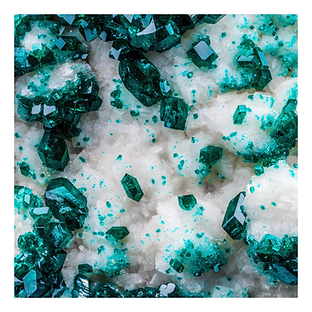

RHODOCHROSITE, PERU
Rhodochrosite on Matrix
Uchucchacua Mine, Uchucchacua area, Oyón District, Oyón Province, Lima, Peru
5.0 x 7.3 x 3.9 cm
Rhodochrosite is a holy grail species for the majority of mineral collectors. The cherry-red color is extremely attractive due to there being a lack of truly red mineral species. Rhodochrosites from Peru typically are seen in rhombohedral habits which tend to exhibit a lighter and more pink coloration, a contrast to the more rare habit, the scalenohedral habit. Rhodochrosites from Peru that form in the scalenohedral habit usually boast rich, bright red color which is clearly visible on this world-class, famous specimen.
This Rhodochrosite specimen has an extremely impressive provenance. The piece was formerly in the elite collection of William Johnson, who is known for refined and beautiful mineral specimens exhibiting perfection. The piece then migrated to the famous collection of Bill Larson, where it resided for a short while, and then was sold into the personal collection of classic mineral aficionado Marshall Sussman. The piece sat amongst Marshall Sussman's finest specimens for a few years. The piece is now in one of the finest private collections in the world.
The crystals on the piece exhibit an aliveness unlike most Peruvian Rhodochrosites. The clarity and luster are significantly better than the majority of specimens that have circulated the high-end mineral market; these crystals glitter like gemstones. The color is also as good as it gets, with bright, cherry-red colors that contrast beautifully against the glittering Calcite coated matrix. This piece ranks amongst the top Peruvian Rhodochrosites in the world.


THE NORTHERN LIGHTS
Fluorite on Chlorite included Quartz
Yaogangxian Mine, Yaogangxian W-Sn ore field, Yizhang Co., Chenzhou, Hunan Province, China
13.0 x 16.0 x 10.8 cm
In 2022, shockwaves went through the mineral collecting world after a very small but unique pocket of Fluorite was struck in the Yaogangxian Mine, which continues to impress and captivate mineral collectors. The 2022 Pocket, or the Northern Lights Pocket produced a color of Fluorite unlike anything seen before. A rich, deep teal color at the core with traces of accentuating vibrant blue and purple edges create a stunning and unreal appearance that has not yet been showcased by any Fluorite-producing locality.
This incredible specimen sparked intrigue and fascination when it was exhibited in Tucson, and went viral on the internet and across all social media platforms several times. Aside from the stunning color, the specimen embodies the ideal traits of the finest mineral specimens. This Fluorite cluster features translucent/transparent cubic crystals of deep teal color with faint blue and purple edges, which rise from a mossy matrix with green Chlorite included Quartz crystals creating spectacular architecture. The stark contrast between the complexly textured, glassy, geometric shapes of the Fluorite crystals with the unique and beautiful matrix enhances the beauty and aesthetic of the specimen.
This piece is the finest matrix specimen from the find, and has already proven to be one of the most memorable Fluorites hailing from China. This Fluorite is quickly becoming a staple of the Yaogangxian Mine, and of the quality that was produced from the very limited 2022 find.


SAPPHIRE, TANZANIA
Sapphire in Amphibolite
Winza, Mpwapwa District, Dodoma Region, Tanzania
7.0 x 6.0 x 5.5 cm
Sapphire is one of the most captivating gemstones in the entire world. Due to this, the desire for gem rough is extremely high, which makes high-end, gem-grade Sapphires almost impossible to come by as intact specimens. Additionally, Sapphire specimens from Winza, Tanzania are especially hard to attain as the Mpwapwa District (during its production years) was a much quieter deposit compared to the more productive Corundum localities like Sri Lanka, Mogok, Myanmar, Kashmir, as well as some deposits located in Australia and Madagascar.
This famous Sapphire is pictured in "Ruby & Sapphire a gemologist's guide" as the only specimen example in the book, and has also graced several elite private collections. This piece was also formerly in the collection of Bill Larson, a collector known for his taste in gem minerals, as well as the two-time Desautels Award winning Irv Brown collection. This masterpiece now resides in a world-class private gem mineral collection.
This piece exhibits traits that very well may be one of a kind. The color is unlike anything else, with ethereal hues of pink, orange, magenta and blue giving the appearance of a swirling evening sky, or a brilliant galaxy. When viewed at the C-Axis, the crystal shows crisp color zoning between bright, neon magentas contrasting beautifully against deep, rich blues. The clarity of the crystal is incredible, showing multiple zones clear enough to be faceted. Light passes through the piece perfectly which allows the crystal to illuminate like a tiffany stained glass window.
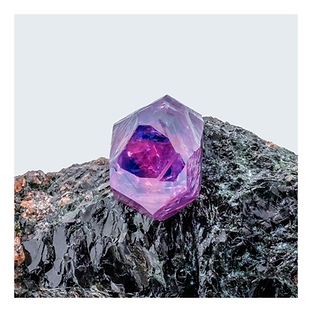

THE EYE OF SHANGBAO
Fluorite on Dolomite
Shangbao Mine, Leiyang Co., Hengyang, Hunan, China
13.0 x 9.7 x 8.5 cm
The Eye of Shangbao is regarded as potentially the best example of Fluorite from the Shangbao Mine in China. This famous specimen was in the private collection of revered and respected mineral dealer, Marcus Budil for many years. The specimen has served as the benchmark that all other Fluorites from Shangbao are compared against since it was unearthed in the mid 1990s. This Fluorite displays every desirable trait, and checks every single box that connoisseurs look for when assessing Shangbao specimens.
This specimen was later purchased by renowned Fluorite experts Wayne A. Thompson and Jason Adams, where the piece exchanged hands between them for many years. The piece was displayed numerous times in Tucson, and was a favorite at every exhibition. This piece holds a multitude of characteristics that make it stupendous and superior to any could-be comparables.
The color of the crystal is the optimal purple color with the bright, violet zoning around the edges. The inky "eye" in the center is deeply colored and contrasts gorgeously against the rest of the piece. The crystal also shows very good luster, atypical for Shangbao material, and boasts an impressive size and isolation - it one of the largest single crystals from the find. The most intriguing trait is the "lift" of the Fluorite crystal. Most Fluorites from Shangbao are buried in and bound to the matrix, while this crystal stands off the matrix exposed on all sides, allowing light to pass through at all angles. This specimen is also published in the Ikons II book, published in 2024.
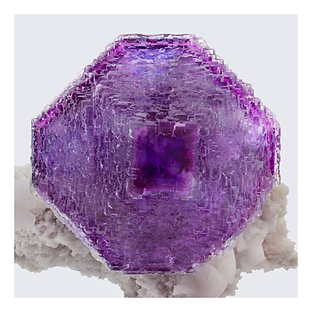
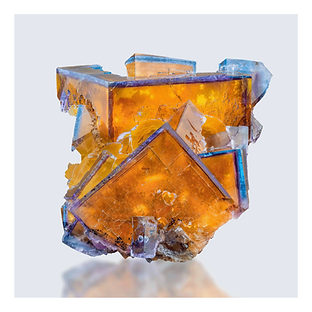
THE RICHARD HECK FLUORITE
Fluorite
Minerva No. 1 Mine, Cave-In-Rock Mining Sub-District, Hardin County, Illinois
12.3 x 17.0 x 14.1 cm
The Richard Heck collection at its peak was one of the finest collections of Illinois minerals ever assembled. There were several extremely high-end examples of Fluorite from Illinois that resided in the collection, but this piece is on an entirely different level. The Illinois Fluorspar district is recognized as the most important Fluorite producing locality in the entire world. The main three mines, namely the Annabel Lee Mine, the Denton Mine, and the most famous mine of all, the Minerva No. 1 Mine have produced some of the most beautiful Fluorites in the entire world.
Whenever truly world-class Fluorites from Illinois appear on the market, it's very important to take notice. The Minerva No. 1 Mine did not begin to produce actual collectible specimens until the late 1980s to the early 1990s. The deposit was industrial, and the majority of the Fluorite that was found would be harvested for hydrofluoric acid that would later be used in steel production. Due to this reality, many of the greatest Fluorite specimens were lost. This unfortunate fact means that there is a very limited supply of truly high-end Fluorite examples in existence.
This particular example displays the coveted tri-color zoning, with a vibrant, warm, yellow-gold core with bright purple and blue "rinds." The luster and clarity of the piece is also exemplary, as the entire piece exhibits glassy faces that are clear enough to see into the inner most portions of the specimen. Lastly, the size of this piece is the most important attribute. To have a Fluorite specimen from Illinois of this size coupled with the many other top-end traits is truly incredible.


THE YAOGANGXIAN IKON
Fluorite on Quartz
Yaogangxian Mine, Yaogangxian W-Sn ore field, Yizhang Co., Chenzhou, Hunan, China
7.0 x 7.8 x 6.8 cm
The Yaogangxian Mine in China has rapidly skyrocketed to the top percentage of high-end Fluorite specimen production. Since the mid 2010s, the mine has produced several of the worlds greatest Fluorites, in addition to many other spectacular mineral species and combinations. One particular hallmark of the Yaogangxian Mine is the fact that the locality continues to shock the mineral collecting world with the incredible color palate of unique, never-before-seen colors. This has made the relatively recent Chinese find a classic in record time.
This specimen is viewed as one of the finest pieces ever recovered from the locality. Several years ago this Fluorite was featured in a New York City exhibition, and is currently pictured in the Ikons II book. This piece was formerly in the elite collections of well-known Fluorite collectors Jason Adams and Wayne A. Thompson, who displayed the piece in 2023 with the entirety of their collections. This exhibition was the highlight of the entire show. Never before was a worldwide Fluorite collection of that caliber displayed. The specimen has since been sold into a private collection.
The color, which can best be described as neon teal is unlike anything else seen before. Even without light, this piece glows like a radioactive isotope. The clarity and luster of the piece are unmatched, as the back of the specimen is clearly visible from the front face. The Fluorite cube sits perfectly nestled atop a bright white, terminated, lustrous Quartz crystal. This specimen truly has a luminescent appearance that makes this piece unforgettable.
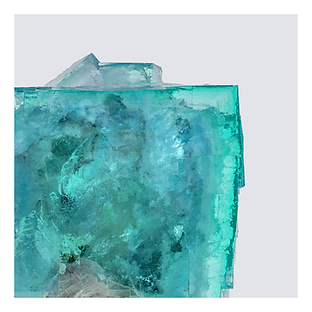

TOURMALINE, BRAZIL
Tourmaline on Lepidolite
Jonas Mine, Conselheiro Pena, Minas Gerais, Brazil
7.0 x 7.0 x 6.8 cm
Tourmaline is one of the most desirable groups to collect when building a fine mineral collection. Within the Tourmaline group, there are certain localities that produced iconic and beautiful specimens that have gone down as true “holy grail” production sites. The Jonas Mine, which was discovered in 1977 in the Conselheira Pena pegmatite district, within the Eastern Brazilian Pegmatite Province, is one of those holy grails. The heyday of the mine was in 1978, when a single pocket was struck that redefined the market for red Tourmaline specimens.
This unrepaired masterpiece remained in an elite private collection for decades, and never was available on the public market. After the specimen was privately sold to an elite gem mineral collector, it went viral across the internet and several social medial platforms. The specimen became an immediate favorite for the majority of mineral specimen enthusiasts.
This is a very rare matrix specimen of ideal, cranberry-red, lustrous Tourmaline crystals from the Jonas Mine, from the world-renowned 1978 pocket that is perhaps the most important and famous single tourmaline discovery in all of mineralogical history. These Tourmalines are unrivaled in terms of color, clarity, and luster and are of a very recognizable style that stand out in any collection or museum immediately. Additionally, it is extremely rare that to have a specimen on truly intact matrix, as the majority of the specimens recovered were single crystals. This piece is a true high-end example that highlights the finest qualities of the find.


SMITHSONITE, NAMIBIA
Smithsonite
Tsumeb Mine, Oshikoto Region, Namibia
13.5 x 12.7 x 12.0 cm
Smithsonites from the famous Tsumeb Mine in Namibia are the most common favorite examples in the mineral collecting world. Nearly all significant Tsumeb minerals were brought into the United States by either Rock Currier or Miriam and Julies Zweibel. The Tsumeb Mine is one of the most collectible localities in the mineral collecting world, and nearly all mineral species are regarded as "classic" and timeless minerals that never go out of style. Representing the finest qualities of Tsumeb minerals is no easy feat, as the competition for world-class Tsumeb material is steep.
This specimen was another member of the elite collection of Irv Brown. The piece is a true connoisseurs specimen, as being able to recognize Smithsonites is a skill that is developed over time. This specimen now resides in a world-class private collection.
There is an array of colors that Smithsonites can exhibit, dependent on which elements are present. In this extremely fine example, both Manganese and Cobalt are present, which is what causes the unique sunset color exhibited by this piece. Due to the piece bearing both Cobalt and Manganese, a mix of deep pink and soft orange colors are present, reminiscent of the color of a Padparadscha Sapphire. This piece is also completely flawless, with not a single point of contact or damage. The crystals on this piece also show wonderful luster, and are shockingly clear allowing light to illuminate the crystals perfectly. This specimen ranks among the finest pink Smithsonites from the Tsumeb Mine.
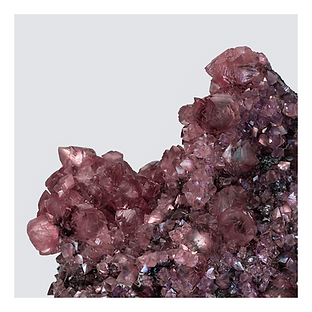

THE STEP STOOL
Fluorite on Fluorite
N/W Crosscut Orebody, Rosiclare Level, Minerva No. 1 Mine, Hardin County, Illinois
9.5 x 10.0 x 9.8 cm
The Minerva No. 1 Mine, arguably the most famous mine in Southern Illinois, is known for producing specimens that often embody exceptional color, zoning, luster, and gem-like qualities. Almost all of the finest examples from the famous mine were collected by a single individual, Ross C. Lillie. The Ross C. Lillie collection is something that may never be rivaled, and will forever be known as the greatest collection of Illinois mineral ever assembled. This specimen is one of the most famous and unique examples from the collection.
The Step Stool was sold privately before the major unveiling of the Ross C. Lillie collection, which took place in 2013. This piece was in the private collection of Andrew K. Ford for several years, until it was sold to an elite private collector.
This specimen could perhaps be the only of its style. The standard three-color zoning pattern is not present, as the blue and purple crystal is not oriented or aligned with the yellow crystal; it is random. The yellow portion of the piece formed first, while a later stage of blue/purple Fluorite formed above it. Due to pocket movement or collapse, it became detached from the wall and settled on top of the yellow Fluorite. The Fluorite was also covered in large Barite spheres at one point, which were dissolved away. The negative spaces in the bottom right section of the specimen exhibit a clear history of crystallized Barite. Lastly, the luster is as good ad it could be, as every face of each crystal is glassy and smooth. This anomalous specimen has no comparables.
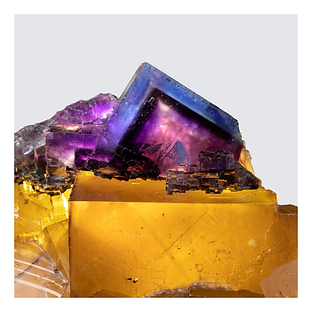

THE COBRA FANGS
Crocoite in Matrix
Red Lead Mine, Tasmania, Australia
10.3 x 8.2 x 7.4 cm
Crocoite is a mineral species that often gets overlooked, as the crystals are extremely brittle and fragile, and rarely do the crystals possess luster or transparency. It is very rare to find truly incredible Crocoite specimens, so the great ones are something very special. Australia has been the premier source for fine Crocoite examples, although Crocoite can also be found in smaller deposits in Germany, Russia, Brazil, the Philippines, and South Africa. Both of the most famous localities, namely the Red Lead Mine, and Adelaide Mines are located in Australia.
Due to the fragility of Crocoite, most specimens lack the presence of complete crystals in matrix, and are usually seen as single crystals, or sprays on matrix. To have crystals that have been safely preserved in a natural "vug" is remarkable, and not something that is typically seen. This remarkable piece was formerly in the collection of two-time Desautels Trophy winner, Irv Brown, and is now in a world-class private collection.
The colors displayed on this piece are as good as they can be, with deep, rich orange colors that exhibit fiery red hues throughout the gemmy crystals. The crystals contrast strongly against the dark matrix, giving an ominous appearance. The clarity of these crystals is incredible, as they truly boast gem-like clarity. The luster makes the crystals appear to be bright orange shards of glass that reflect light like a mirror. The aesthetic of the two parallel, 7 centimeter long crystals are redolent of a King Cobra's fangs, hence the namesake of this incredible specimen.

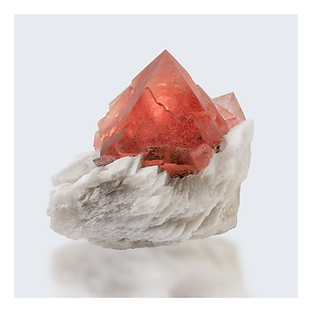
FLUORITE, FRANCE
Fluorite on Calcite
Aiguille Verte, Chamonix, Chamonix-Mont-Blanc, Bonneville, Auvergne-Rhône-Alpes, France
8.7 x 8.8 x 8.0 cm
Red Fluorites from the French Alps are one of the most elusive and desirable things to chase in the high-end mineral world. These treasures are instantly recognizable due to their striking color contrast. The nature of these pieces is extremely special. Only for a few months a year is it safe enough for Strahlers (mountaineer crystal miners) to scale the French Alps in search of these highly coveted specimens. Additionally, nearly all of the specimens of significant consequence have found homes in private collections, and are likely to never to surface on the open market.
This specimen has a very impressive resume, originally residing in the collection of famed collector Marcus Budil, who was known to have the finest alpine material. The piece sat with Budil for several years, until it was sold to Wayne Thompson, a renowned figure in the mineral world. From there it went to the famous Fluorite collection of Jason Adams. The piece then found its way into an elite private collection, where it will likely reside forever.
This piece shows the most desirable of traits. The bright red Fluorite octahedron sits aesthetically perched atop a lovely, bladed, white Calcite matrix. This piece also shows impressive clarity, which is very uncommon for the red Fluorites from France. Additionally, there is no restoration work whatsoever on this piece. This is an important attribute, as many of the finest French Fluorites have restoration work. The overall visual beauty of the specimen delivers a powerful appearance, as light passes through the crystal making it glow like a fiery ember.


FLUORITE, NEW YORK
Fluorite on Dolomite
Penfield Quarry, Penfield, Monroe County, New York, USA
9.8 x 8.0 x 6.7 cm
Fluorite specimens from the Penfield Quarry, located in Monroe County, New York, are among the most coveted yet challenging minerals to obtain from the northeastern United States. This locality—situated within the Lockport Dolostone of Silurian age—has a long history of yielding fine mineral specimens; however, access to the site is now highly restricted. The quarry typically opens to collectors only for a very limited period each year, making opportunities to recover new material exceedingly rare.
Fluorite crystals from Penfield are typically small, most measuring less than a few centimeters across, and are most often encountered as isolated, single cubes rather than clusters or matrix-bound specimens. Well-formed crystals that remain attached to their Dolostone matrix are particularly scarce and highly prized. The color of Penfield Fluorite is generally subdued, displaying delicate hues that range from nearly colorless to a faint, pale blue. Very few specimens exhibit the optimal traits; this piece being the standard for the locality.
This particularly famous specimen belonged to the collection of William Johnson, and later an esteemed private collection in Texas. This specimen remains definitely the largest intact Fluorite specimen of this quality from Penfield. The piece exhibits the finest color combinations attainable and boasts gem-like clarity that allows the matrix to be visible through the crystal. Because of the quarry’s limited accessibility, the fragile nature of the crystals, and the scarcity of vividly colored or matrix specimens, this Fluorite is a holy grail specimen.


KÄMMERERITE, TURKEY
Kämmererite
Kop Krom Mine, Kop Daglari, Aşkale District, Erzurum Province, Turkey
9.2 x 2.7 x 8.8 cm
Kämmererite is a rare, purple to pink variety of the mineral Clinochlore. The species got its name in 1841 by Nils Gustaf Nordenskiöld as a tribute to August Alexander Kämmerer, who was a lead chemist in the Mining Department of Russia. Kämmerer was also the author of several impactful geological writings, as well as pharmaceutical works, and was a true early-modern period Renaissance Man. Finding a truly fine Kämmererite specimen is difficult, as there are few exceptional specimens.
This specimen sat in a private collection for decades, and was never photographed, published, or shared. It sat in the bottom of a box, waiting to be discovered. The piece exhibits the top attainable qualities for the species, which are rarely all seen together.
Even the finest known Kämmererite specimens tend to be littered with damage due to the fragility of the species. This specimen is in exceptionally good condition, showing minimal points of contact. The color of the Kämmererite crystals is the most optimal color; a neon, violet color. Typically the species contains darker and purple crystals. The clarity and gem-like qualities of these crystals is also remarkable, as most of the crystals are completely transparent. The size of these isolated crystals is also something that stands out, as well as the neat and even placement of them. The last, but most important attribute of the piece is the contrast. The bright fuchsia matrix frames the rich, violet crystals perfectly. Most examples do not exhibit this contrast.


FLUORITE, ILLINOIS
Fluorite with Barite inclusions
Minerva No. 1 Mine, Cave-In-Rock Mining Sub-District, Hardin County, Illinois
9.5 x 10.0 x 9.8 cm
Fluorite hailing from Illinois is the conventional preference amongst mineral collectors. The color, luster, brilliance, and luminescent appearance that is possible within each of these masterpieces make them an easy favorite amongst the entire Fluorite species. Out of all of the production sites in Illinois, the Minerva No. 1 Mine has produced the most magnificent examples. World-class Fluorites from any of the Illinois mines are holy grail, as the mines were industrial and not meant for collectible specimen recovery. Many amazing specimens were lost because of this.
This exquisite example of Fluorite from the Minerva No. 1 Mine has a very impressive provenance. The specimen resided in the esteemed Ross C. Lillie collection of Illinois minerals, which was the finest assemblage of Fluorite, among other minerals from Illinois to ever exist. This piece was debuted in the 2013 sale of the Ross C. Lillie collection, and was a very early pick by Irv Brown. The piece remained in the Irv Brown collection for several years, and was part of both of his Desautels Trophy winning exhibits.
One of the rarest and most attractive forms of Fluorite from Illinois is complete and euhedral, yellow crystals exhibiting ideal color and brilliant, glass-like luster. Additionally, the presence of unaltered, complete Barite inclusions that are so clearly visible is exceedingly uncommon. This top-quality specimen, which has never been repaired or restored displays some of the finest, rarest and most desirable traits possible in Fluorite specimens from Illinois.
